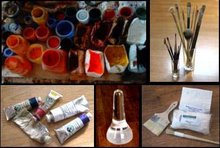W.F. Martin's Glazing Mediums
Some time ago I read an online article entitled 'Glazing with Oils' by William Martin at wetcanvas.com. In this article he demonstrates the stages of a highly realistic still life painting, using 3 separate glaze mediums at different stages. I was inspired enough to want to try out these glaze mediums for myself (see 'Still Life with Aubergine' and 'Still Life with Books'). Here are my initial findings.
'Lean' Medium: this is the first of the 3-stage medium recipes, and is made up as follows:
- 5 parts Turpentine (or Oil of Spike)
- 1 part Damar Varnish (or Venice Turpentine)
- 1 part Stand Oil
I have used this for underpaintings by mixing a little bit of medium in with each brush-load of paint. In some cases I may not have used quite enough, as the underpainting was not quite dry the following day (possibly due to using flake white ground in slow-drying poppy oil). But general I have no complaints with this medium.
'Medium' Medium (I know that doesn't sound right!) This is the second glaze recipe and is made up as follows:
- 2 parts Turpentine (or Oil of Spike)
- 2 parts Damar Varnish (or Venice Turpentine)
- 1 part Linseed Oil
Personally I chose to use spike oil and venice turpentine for my mixture, and the result is a beautiful-smelling medium! With this medium I reverted to my preferred method of applying the mixture thinly to the canvas/panel and painting into it with neat paint. I can say that of all mediums that I have used, this one is the most joyous to paint with. The paint flows so smoothly, and the surface is reliably dry by the following day, as long as the paint is not applied too thickly over the medium.
'Fat' Medium: this is the final glaze recipe, only to be used for the topost layer(s) of the painting. It is made up of:
- 2 parts Turpentine (or Oil of Spike)
- 1 part Damar Varnish (or Venice Turpentine)
- 2 parts Sun Thickened Linseed Oil
Again, I chose to use spike oil and venice turpentine, resulting in a wonderful smell. So far I have only used this on my Still Life with Aubergine painting. I rubbed this medium thinly into the canvas with the palm of my hand, and then painted into it with neat paint. I enjoyed the flow of paint and the surface was fully dry after a couple of days.
So, to summarise, I think it is fair to say that these are very enjoyable mediums to use, and most suited to THIN layers of painting where visible brush strokes are not required. One thing I have noticed is that my finished aubergine painting lacks glossiness, and will need to be varnished.
- For more info, click on the link below to read William Martin's full article: Bill Martin's Glazing medium demonstration
- Also view the step-by-step images of the aubergine painting on the still life page:

No comments:
Post a Comment